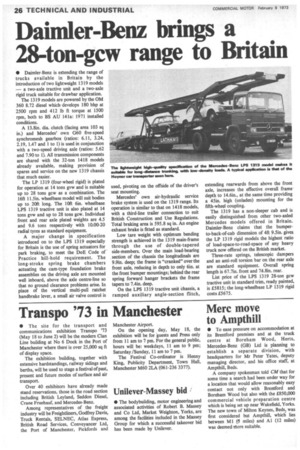Daimler-Benz brings a 28-ton-gcw range to Britain
Page 28

If you've noticed an error in this article please click here to report it so we can fix it.
• Daimler-Benz is extending the range of trucks available in Britain by the introduction of two lightweight 1319 models — a two-axle tractive unit and a two-axle rigid truck suitable for drawbar application.
The 1319 models are powered by the OM 360 8.72 diesel which develops 180 bhp at 2500 rpm and 412 lb ft torque at 1500 rpm, both to BS AU 14Ia: 1971 installed conditions.
A 13.8in. dia. clutch (facing area 103 sq in.) and Mercedes' own G60 five-speed synchromesh gearbox (ratios: 6.11, 3.24, 2.19, 1.47 and 1 to 1) is used in conjunction with a two-speed driving axle (ratios: 5.62 and 7.90 to 1). All transmission components are shared with the 32-ton 1418 models already available, making provision of spares and service on the new 1319 chassis that much easier.
The LP 1319 (four-wheel rigid) is plated for operation at 14 tons gvw and is suitable up to 28 tons gcw as a combination. The 16ft 11.5in. wheelbase model will suit bodies up to 20ft long. The 10ft 6in. wheelbase LPS 1319 tractive unit is also plated at 14 tons gvw and up to 28 tons gcw. Individual front and rear axle plated weights are 4.5 and 9.6 tons respectively with 10.00-20 radial tyres as standard equipment.
A major change in specification introduced on to the LPS 1319 especially for Britain is the use of spring actuators for park braking, to meet the DoE Code of " Practice hill-hold requirement. The long-stroke spring brake chambers actuating the cam-type foundation brake assemblies on the driving axle are mounted well inboard, above the axle centre-line so that no ground clearance problems arise. In place of the vertical multi-pull ratchet handbrake lever, a small air valve control is used, pivoting on the offside of the driver's seat mounting.
Mercedes' own air-hydraulic service brake system is used on the 1319 range. Its operation is similar to that on 1418 models, with a third-line trailer connection to suit British Construction and Use Regulations. Total braking area is 595.8 sq in. An engine exhaust brake is fitted as standard.
Low tare weight with optimum bending strength is achieved in the 1319 main-frame through the use of double-tapered side-members. Over the main load-bearing section of the chassis the longitudinals are 9.9in. deep; the frame is "cranked" over the front axle, reducing in depth to only 6in. at the front bumper mountings; behind the rear spring forward hanger brackets the frame tapers to 7.4in. deep.
On the LPS 1319 tractive unit chassis, a ramped auxiliary angle-section flitch,
extending rearwards from above the front axle, increases the effective overall frame• depth to 14.6th., at the same time providing a 45in. high (unladen) mounting for the fifth-wheel coupling.
The 1319 has a non-sleeper cab and is easily distinguished from other two-axled Mercedes models offered in Britain. Daimler-Benz claims that the bumperto-back-of-cab dimension of 4ft 9.5in. gives the LP 1319 rigid models the highest ratio of load-space-to-road-space of any heavy truck now offered on the British market.
Three-rate springs, telescopic dampers and an anti-roll torsion bar on the rear axle are standard equipment. Overall spring length is 67.7in. front and 74.8in. rear.
List price of the LPS 1319 28-ton gcw tractive unit in standard trim, ready painted, is £5815; the long-wheelbase LP 1319 rigid costs £5675.
































































































